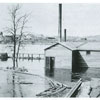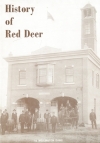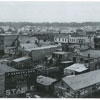The First Boom and Bust and World War I (1900-1918)

Red Deer and area experienced tremendous growth between 1900 and 1913. The construction of the Grand Trunk Pacific Line from Calgary to Edmonton in 1910 increased the flow of traffic in the area allowing agriculture and forestry to become the mainstay of Central Alberta's economy in the first decade of the 20th century.
Railroad speculation allowed settlements around Red Deer to flourish.

One of these growing settlements was Stettler. Stettler (originally named Blumenau) began in 1903, when Carl Stettler of Switzerland settled in the area. A Swiss-German colony formed the Hamlet of Blumenau around Stettler's homestead. Stettler experienced the bulk of their growth later than its surrounding communities. When the Lacombe-Stettler branch line was built in 1905, Stettler began to grow at an accelerated rate. In 1906, Stettler became both a village and later a town, in the span of only 5 months.
Camrose, then called Sparling, experienced its first building boom between 1904 and 1905. When the CPR station was built there in 1905, Camrose was incorporated as a village.
Railway speculation was responsible for the growth of the Sylvan Lake Townsite. The Alberta Central Railway, constructed from 1910 to 1914, to link Red Deer and Rocky Mountain House, helped Sylvan Lake to grow. At the time, it was already becoming a summer resort for residents of Red Deer, as they camped and began to build summer cottages. Sylvan Lake was officially incorporated in 1913, an event still celebrated annually during “1913 Days.” The town’s permanent population, however, was quite small – only 185 in 1923.
The Village of Rocky Mountain House, near the old fur trading post, was created through railway speculation, at the arrival of the Alberta Central Railway and the Canadian Northern Railway to the area in 1912. A small business community developed near the railway terminal in 1911. However, a new townsite was soon chosen farther away from the terminal, on the homestead of J.H. Bertrand. In 1912, the Village of Rocky Mountain House. Rocky Mountain House was, for a time, overshadowed by Nordegg, home to the Brazeau Collieries coal mines. But Rocky Mountain House became dependant not on the coal industry, but its lumber industry, which became one of the largest in the west.
In 1911, Ponoka, experienced significant population growth when the Provincial Mental Hospital was built there. Built over 2730 acres to accommodate nearly 200 patients, the hospital was a three storey building surrounded by several smaller buildings; the hospital continues to maintain a significant presence in the community.
The prosperous village of Red Deer became a town in 1901. Under Red Deer's new mayor, Raymond Gaetz, the appearance of the town soon improved. In response to stricter fire regulations, new brick buildings began dotting the downtown landscape. Some of these notable buildings were the Alexandra Hotel (1902), the Purdy Opera House (1903), and the H.H. Gaetz Block (1903). The construction of new buildings using brick prompted the need for a new brickyard.

The growth in agriculture surrounding Red Deer warranted a new grain mill, grain elevator, flour mill, and warehouses for farm implements. Public buildings included a hospital and a courthouse. Utilities were brought to town by the Western Telephone Company, Western General Electric and Bell Telephone by 1905. The fire of 1904 that destroyed Michener Block prompted the building of Fire Hall No. 1 in 1906. The growing city gained two newspapers within this period - the Red Deer News and the Alberta Advocate. 1907 was the peak year for Red Deer's economic development when Red Deer was designated a divisional point by the Canadian Pacific Railway. For this purpose, a new railroad bridge, coal chutes, and water tower were built. However, Red Deer also witnessed some turbulent times during 1907 highlighted by a dreadful winter that damaged crop production. Moreover, the Red Deer Mill and Elevator Company went bankrupt, and a large fire destroyed the opera house, a furniture store, meat market, and many other small shops.

By 1909, Red Deer was headed towards its greatest boom in history and would soon establish itself as a city. Railroad expansion boosted the economy. CPR built a new railroad station in 1910, and the Alberta Central Railway and the Canadian Northern Railway were planning lines through the district of Red Deer. Farmers and merchants both had growing markets and the construction industry could not keep up with the influx of newcomers. Within two years, the population increased by nearly 1000. The Town of Red Deer was on its way to becoming a major manufacturing centre as Square Garments Ltd., Freytag Tannery Co., and Laurentia Milk Company moved in during the boom. The Town of Red Deer gained two new public schools, a park system, several new churches, and the Alberta Ladies College. 1912 showed tremendous growth with building permits totaling $355,000, up more than $100,000 over 1911. Numerous manufacturing industries and wholesalers moved in. The growth was so staggering that on March 25th of 1913, Red Deer became Alberta's sixth city.

Red Deer's growth, however, was not sustainable. All across Alberta, careless real estate speculation left investors with empty subdivisions that were not selling. Land prices were artificially inflated, creating paper profits but not real profits. Speculators could no longer afford the property taxes so much of the land was sold back to the city for back taxes. Central Alberta's towns and villages experienced debt crises after years of rampant growth and economic development.
Red Deer was on the verge of bankruptcy. The council was heavily in debt due to overspending. By 1914, the debt mounted to $440,000. Floods, a failing sawmill industry, and an exodus of homesteaders created an economic downturn. All the while the City's income was steadily decreasing. The treasury was empty meaning the City could no longer afford utilities or pay their own employees. Further perpetuating the downfall, the banks would no longer give the City of Red Deer anymore credit. The population stagnated. In 1911, Red Deer was home to 2,118 people, and would only grow by 210 in the next ten years.
Red Deer found some salvation when oil was discovered at Turner Valley in 1914. Real estate agents benefited immediately as entrepreneurs began buying land in hopes of striking rich on the newly discovered Turner Valley oil. The city tried to profit as well by forcing brokers to pay license fees, much to the chagrin of the real estate community. In the end, the entire community benefited through the founding of several oil companies including the Red Deer Oil and Gas Company, the Central Alberta Oil, and the Innisfail Pioneer Oil Company. However, when new drilling efforts in the area came up empty-handed, the boom soon climaxed. The arrival of World War I brought still more hardships to the area.
During the First World War, Red Deer was the main recruiting station for Central Alberta. The city lost much of its labour force to enlistment. A flood in June of 1915 washed away roads, and damaged the power plant, lumbermill, and CN railroad. The economic slump forced two of the city's three hotels to shut down as well as the Great West Lumber Mill. Finally, the City of Red Deer reached a low point in its finances. In 1916, the Bank of Montreal cut off the City's credit. The province was forced to step in by allowing the City to issue treasury bills secured by the amount of taxes in arrears. But the city continued to spiral into debt, as citizens could no longer pay taxes, and the City was forced to default on bond payments. By the end of the war in 1918, Red Deer was still debt and its industries were failing.
Bibliography
Dawe, Michael. Red Deer: An Illustrated History.
Red Deer and District Museum Society, the City of Red Deer Archives and the Red Deer Visitor and Convention Bureau, 1996.
Hambly, J.R. Stan, Ed. A Light into the Past: A History of Camrose 1905-1980. Camrose Historical Society, Gospel Contact Press, 1980.
Keer, Stephani. “In the Bust the Smallest City took the Hardest Hit.” Alberta in the 20th Century, Vol. 3: The Boom and the Bust 1910-1914.
Meeres, E.L. The Homesteads that Nurtured a City: The History of Red Deer. Red Deer: E.L. Meeres, 1977, 1984.
Packhorse to Pavement. Buck Lake Historical Society, 1981.
Pioneers and Progress. Alix Clive Historical Club, 1974.
Ponoka 1904 to 1954: 50th Anniversary. Ponoka Herald, ~1954.
Sylan Lake Chamber of Commerce. “A Brief History of Sylvan Lake.” Retrieved March 27, 2009 from http://www.sylvanlakechamber.com/history.htm
The Days after Yesterday: Rocky Mountain House / Nordegg and Area History. Rocky Mountain Alberta: The Rocky Mountain House Reunion Historical Society, 2003.
The Days Before Yesterday: History of Rocky Mountain House District. Rocky Mountain House, Alberta: Rocky Mountain House Reunion Historical Society, 1977.
Town of Rocky Mountain House. “Visiting Rocky.” Retrieved March 30, 2009 from http://www.rockymtnhouse.com/visiting-history.htm
Town of Sylvan Lake. “About Our Town.” Retrieved March 27, 2009 from
http://www.town.sylvan-lake.ab.ca/about.htm





